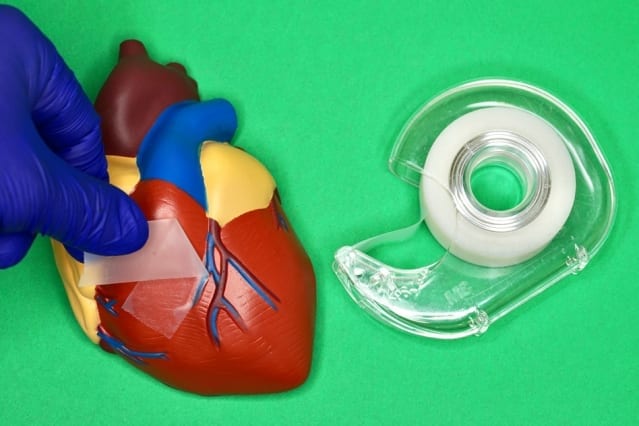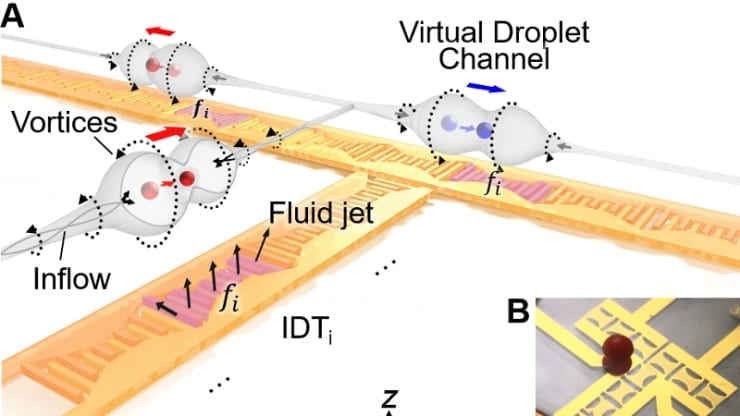
This is like a painless Band-Aid for internal organs,” says Xuanhe Zhao, professor of mechanical engineering and of civil and environmental engineering at MIT. “You put the adhesive on, and if for any reason you want to take it off, you can do so on demand, without pain.”
Courtesy of the researchers
Removable adhesive could make it easier for surgeons to close up internal wounds.
Last year, MIT engineers developed a double-sided adhesive that could quickly and firmly stick to wet surfaces such as biological tissues. They showed that the tape could be used to seal up rips and tears in lungs and intestines within seconds, or to affix implants and other medical devices to the surfaces of organs such as the heart.
Now they have further developed their adhesive so that it can be detached from the underlying tissue without causing any damage. By applying a liquid solution, the new version can be peeled away like a slippery gel in case it needs to be adjusted during surgery, for example, or removed once the tissue has healed.
“This is like a painless Band-Aid for internal organs,” says Xuanhe Zhao, professor of mechanical engineering and of civil and environmental engineering at MIT. “You put the adhesive on, and if for any reason you want to take it off, you can do so on-demand, without pain.”
The team’s new design is detailed in a paper published today in the Proceedings of the National Academy of Sciences. Zhao’s co-authors are first authors Xiaoyu Chen and Hyunwoo Yuk along with Jingjing Wu at MIT, and Christoph Nabzdyk at Mayo Clinic Rochester.
Unbreakable bonds
In considering designs for their original adhesive, the researchers quickly realized that it is extremely difficult for tape to stick to wet surfaces, as the thin layer of water lubricates and prevents most adhesives from taking hold.
To get around a tissue’s natural slipperiness, the team designed their original adhesive out of biocompatible polymers including polyacrylic acid, a highly absorbent material commonly used in diapers and pharmaceuticals, that soaks up water, then quickly forms weak hydrogen bonds with the tissue’s surface. To reinforce these bonds, the researchers embedded the material with NHS esters, chemical groups that form stronger, longer-lasting bonds with proteins on a tissue’s surface.
While these chemical bonds gave the tape its ultrastrong grip, they were also difficult to break, and the team found that detaching the tape from tissue was a messy, potentially harmful task.
“Removing the tape could potentially create more of an inflammatory response in tissue, and prolong healing,” Yuk says. “It’s a real practical problem.”
Scotch tape for surgeons
To make the adhesive detachable, the team first tweaked the adhesive itself. To the original material, they added a new disulfide linker molecule, which can be placed between covalent bonds with a tissue’s surface proteins. The team chose to synthesize this particular molecule because its bonds, while strong, can be easily severed if exposed to a particular reducing agent.
The researchers then looked through the literature to identify a suitable reducing agent that was both biocompatible and able to sever the necessary bonds within the adhesive. They found that glutathione, an antioxidant naturally found in most cells, was able to break long-lasting covalent bonds such as disulfide, while sodium bicarbonate, also known as baking soda, could deactivate the adhesive’s shorter-lasting hydrogen bonds.
The team mixed concentrations of glutathione and sodium bicarbonate together in a saline solution, and sprayed the solution over samples of adhesive that they placed over various organ and tissue specimens, including pig heart, lung, and intestines. In all their tests, regardless of how long the adhesive had been applied to the tissue, the researchers found that, once they sprayed the triggering solution onto the tape, they were able to peel the tape away from the tissue within about five minutes, without causing tissue damage.
The Latest Updates from Bing News & Google News
Go deeper with Bing News on:
Removable adhesive
- Relink Technology: A Game-Changer for Adhesive Tapes Removal
Adhesive tapes possess remarkable capabilities and are crucial elements in numerous demanding applications requiring high-end bonding, protection, and insulation. Despite advancements, frustrations ...
- Medical Adhesives in the NICU
Adhesive products are selected based on the intended purpose, as well as the anatomic location the adhesive will be attached. An important patient consideration is the type of device being secured ...
- Medical Adhesives in the NICU
Skin injury results when the skin to adhesive attachment is stronger than skin cell to skin cell attachment. As a result, the epidermal layers separate or the epidermis separates completely from ...
- Don’t Be Intimidated By Peel-And-Stick Wallpaper—9 Things To Know Before Installing It In Your Home
Phone a friend. “Installing peel-and-stick wallpaper is definitely a two person job, so don’t attempt it alone,” says Senior Lifestyle Editor Ivy Odom, who installed removable wallpaper in her work ...
- The Best Ways to Soundproof Your Home on a Budget
One of the fundamental tools of soundproofing is the foam acoustic panel. While these are used to dampen echoes and sound within a room, they can also be very effective at dampening sound coming ...
Go deeper with Google Headlines on:
Removable adhesive
[google_news title=”” keyword=”removable adhesive” num_posts=”5″ blurb_length=”0″ show_thumb=”left”]
Go deeper with Bing News on:
Adhesive
- The Brilliant $13 Find That Instantly Lit Up the Darkest Corner of My Kitchen (No Drill Necessary!)
It actually didn’t take long to find exactly what I was searching for. I wanted something small and discreet, but powerful, and Amazon shoppers led me right to it. With over 500 purchased in the past ...
- Adhesive bonding failure caused aircraft crash, report finds
A failure of adhesive bonding was the cause of an aircraft crash, an investigation has found. The Air Accidents Investigation Branch published its report on the VA-1X, G-EVTL crash at Cotswold Airport ...
- Henkel, Kraton and Dow Jointly Drive Sustainability in North American Consumer Goods Industry
TECHNOMELT® SUPRA 100 LE and TECHNOMELT® SUPRA 106M LE formulas designed with biobased alternatives reduce the adhesives’ cradle-to-gate carbon footprint by 25%1 compared to the legacy products.
- Strong shape-memory adhesive could put Spider-Man to shame
You can stop skulking around labs trying to get bitten by radioactive spiders – a new breakthrough could make it easier than ever to get Spider-Man’s wall-crawling powers. Scientists in Singapore have ...
- New research raises questions about potentially toxic components of popular bandage products: 'It doesn't make sense for these companies to use it'
In 65% of bandage varieties, testing discovered high levels of a marker that indicates the presence of toxins.
Go deeper with Google Headlines on:
Adhesive
[google_news title=”” keyword=”adhesive” num_posts=”5″ blurb_length=”0″ show_thumb=”left”]










